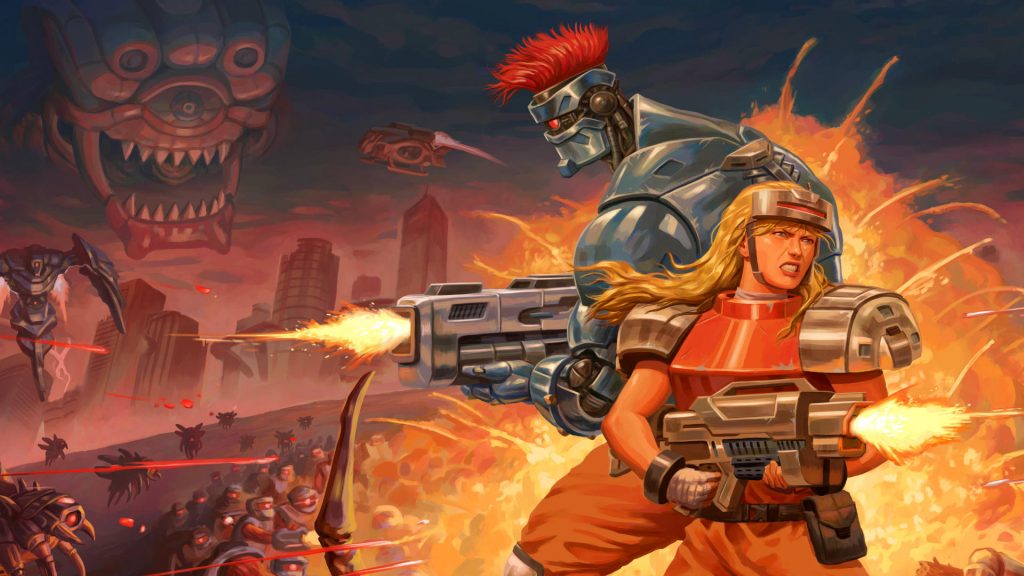Video Gamer is reader-supported. When you buy through links on our site, we may earn an affiliate commission. Prices subject to change. Learn more
One dried up decade, two games in two weeks, one winner, and one loser. Such has been the experience of playing Stranger Things 3: The Game followed by Blazing Chrome. Both games hark back to the ‘80s – which has started to resemble a cultural scab, swathed in spandex, that might heal if only every show, game, and film would stop picking at it. But where Blazing Chrome, which is cut from a Contra template, javelins into your nervous system and plays to the strengths of its past, Stranger Things couches itself in the neon-lit longing of the show – which is beginning to feel dim and depleted – and jams in genres and mechanics from the present. So how come the forward-thinker falls backwards and the old-timer feels like it’s blazing a trail?
Well, one answer is story. At first, the name ‘Stranger Things 3: The Game’ sounds like a seal of quality – official assurance of both strangeness and things, presented with the authentic glow of the recent season’s summer nights. But it soon sounds more like a threat. The game is glued to plot of the show, with static text-only cutscenes as engaging as white noise. If you’ve arrived straight from Netflix, playing this feels as though a computer from the ‘80s had devoured all eight episodes and the resulting slurry – pixellated, stripped down, and sped up – is being beamed, or barfed, into your brain. Any jolt of surprise or, if you haven’t caught season 3, any lick of narrative coherence crumbles under the need to recreate scattered scenes in the hopes of making frothy puddles of people desperate for another fix.
Now consider the first minute of Blazing Chrome, which gives you a banquet of information with one slow downward drift of the camera. The clouds look like coils of bloody intestine, slithering across the sky; the buildings beneath are all broken; and the ground is cobbled with skulls, both human and robot. The entire thing looks like it’s been lit by a lightbulb that’s been dipped in blood. You might have thought that Blazing Chrome would have the superior pace of action, but who would have thought it would have the better upside down? This is a hell dimension! Evidently, Humans and robots have continued their rich and romantic tradition of grievously not getting along. Two figures – an armoured woman with a whip of blonde hair and a beefy robot with a scarlet mohawk – stand atop the rubble ready for action.
Who wants to flip through thick wedges of silent dialogue when a single glance at this will get you up to speed? And who cares that the opening cutscene scrapes by frame by frame? Blazing Chrome’s developer, JoyMasher, has taken up the hardware limitations of the 1980s (albeit with a luxurious 16-bit gloss) as self-imposed gospel and treats it as editorial imperative; hence the laser-cut starkness of the story and the action, which you’re hurled into like a Terminator treading back in time. I found myself completely won over by the game’s relish for the inexhaustible surge of the side-scrolling shooter campaign – as brief and frictionless as a bullet. It’s all very well having reverence for a time that’s already slipped by, but how about having respect for the time that trickles away while we play?
No such courtesy in Stranger Things 3: The Game, which has us, for the first half-hour, ferrying shampoo to Mike’s mom at the swimming pool before schlepping back to the mall for some other thingamajig and whacking rats on the way with a baseball bat. Not only is the combat as interesting as wallpaper, but the bursts that we get of it are chopped up and tossed in a stale salad of fetch quests. Then, for some reason, there’s a quest log, which lists both primary and secondary missions as if there were any difference – both involve backtracking and whacking your foes with a bat, or a slingshot, or, rather disturbingly, slashing at them with a pair of scissors.
By way of spice – or, more accurately, clutter – we are given a crafting menu (a refugee from the rash of such mechanics that present day action games have yet to find an ointment for). Stopping off at workbenches, you can jumble together ‘Trinkets’ – tied-up bundles of firecrackers, a Freddy Krueger-clawed glove, a tactical protective helmet etc. It might have come off as a paean to the lick-and-stick craft of crappy homemade toys, and thus to an era where imagination held greater sway over young minds.
What it ends up being is boring, and a perfect summation of the game as a whole: a disposable trinket of taped-together mechanics that requires quite an imagination (or perhaps a desperate yearning) to enjoy. Alas, mine was elsewhere, drifting off to the rusty shores of Blazing Chrome, where alien insects were scything through the skies above and mounds of monstrous flesh were plugged into hard, metallic plates of armour, with snaking necks and pummeling fists. It all seems like the frenzied crayon scrawl of a child, cooking up monsters and dreaming of thrills. In other words, the product of some imagination.

